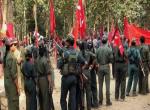Prime Minister Mr Manmohan Singh has been reiterating a word of caution about the increasing threat of Left Wing Extremism. Few weeks ago, he conveyed the high sign of losing out a double digit sustained growth rate unless the mineral rich Central India as well as the tribal population are freed from the clutches of the Maoist menace.1 The challenge in front of the nation, as mentioned by the Prime Minister, is arduous for it implies containing an extremist organisation which prevents the nation to put its own resources to optimum use but thrive on them successfully.
A noteworthy media report, in the same week, quoted an intelligence evaluation that the Maoist kitty has a fund of more than Rs 2,500 crore.2 The report cites the central intelligence bureau that this whopping amount was collected by the CPI (Maoist), the prominent Maoist organisation, in the last 12 months. The figures may appear incredible, but this estimation prompts serious scrutiny regarding the funding mechanism of the ‘nation’s single largest internal security threat'.
There were many official evaluations regarding the volume of the Maoist funds in 2009, including that of the Home Secretary Mr G K Pillai, who speculated it to be around Rs 1,400 crores.3The Chhatisgarh DGP, Mr Vishwaranjan states that the Maoist funds may be a minimum of Rs 2,000 crores, for which the major source is extortion.4 Information regarding the funding has been revealed by many arrested and surrendered Maoists. Misir Besra, a Central Committee member of CPI (Maoist) arrested in 2007, revealed that the outfit collected over Rs 1,000 crore in 2007 and had set a target of Rs 1,125 crore for 2008. As per the above mentioned news report, around Rs 1,000 crore was from Jharkhand, while West Bengal and Chhattishgarh contibuted their shares of Rs 500 crore each. The funds of Bihar and Andhra Pradesh state committees were Rs 200 crore and Rs 100 crore respectively. The Chhattisgarh Chief Minister, Mr Raman Singh has agreed a year ago that the funding for Maoist from Chhattisgarh alone would touch a minimum of 150 crore.5There is no argument that these bits of information are pointers to a more perilous situation posed by a mightier Maoist movement of the future.
The chapter 13 of the Constitution of CPI (Maoist) deals with the funds of the organisation and the article 17 reminds the members that fund collection is one of the important duties of any Maoist. But in a recent interview, Maoist General Secretary Ganapathy denied the reports of huge amount of funds and says that they do not even get one per cent of what they are accused of.6 But he accepts that they collect levies from contractors in addition to ‘donations from people’. Various studies as well as statements of arrested leaders have revealed that they have various potential sources of funding including extortion, levies, poppy cultivation etc.
Narla Ravi Sharma, in charge of Bihar – Jharkhand Special Area Committee, arrested in October 2009 revealed that big corporations doing business in Maoist areas are the most important sources of funds for the Maoists. These industries, which are mainly into mining, manufacturing, metals etc., have only the options of either paying what the Maoists demand or closing their businesses in those areas. According to a security expert, this is reminiscent of the manner in which the north eastern insurgent groups including the ULFA extorted money from tea plantations and oil companies. The companies give their excuse that the government does not provide adequate security and therefore they have to succumb to Maoist demands. The Maoists blew up the guest house of mining corporation Essar in Malkangiri for the same reason. Abhijit Group, another private company into power generation in Jharkhand, claims that they were attacked and four of their security guards were killed for refusing to pay the Maoists. Jharkhand which contributes the major share to the Maoist exchequer has the bulk of the corporations including Rungta Mines, Usha Martin, Torian Iron & Steel etc. which have allegedly paid Rs. 25 lakhs each, the Birla Bauxite Company in Palamau which paid Rs. 80 lakhs, Latehar based Tetaria Mines which has paid Rs. 2 lakhs to the Maoists in 2007-08 and many more. As it happened with Hindalco in Jharkhand, the Maoists even abduct the employees of defaulters.7 The Maharashtra Home minister R.R. Patil says, 'Several mines are located in Naxal-affected areas. Those involved in the mining business are providing financial muscle to the Naxal movement'.8 Another report on the situation in Bengal says that the insurgents collect Rs 8 lakhs to Rs 10 lakhs per month from stone-crushing units, sponge iron factories, contractors, businessmen and even school teachers in the state, especially Jangal Mahal.
The levies from contractors, which even Ganapathy has accepted, are another major source of funds for the outfit. The Maoists charge commissions and levies from all non-governmental agencies working in their areas of influence including Tendu contractors, road and other civil construction contractors, bus and truck owners, petrol pumps, and even shop keepers. There is a great irony in the situation which is similar in most of the Maoist affected states that the police fail to prevent these contractors from paying up the Maoists but has to motivate them in order to take up projects in areas where government agencies cannot reach for development works.9 In Chhattisgarh, for example, the police has to depend on private contractors to build roads, bridges etc in many interior regions of Danetwada, Bastar, Bijapur etc where the Maoists has an upper hand over the administration. The extremists have even fixed rates of levy like 10 per cent of the project cost for those making unpaved roads to 5 per cent for small bridges and others. The bus and truck operators claim this to be Rs. 1,000 to Rs. 5,000 per month, from region to region. If they fail to pay, they may not be allowed to operate in those areas and their properties destroyed. The Secretary (Rural Development), Government of Jharkhand, Mr S.K. Satpathy claims that the Maoists have blocked 21 road construction projects sanctioned under the Pradhan Mantri Gram Sadak Yojana due to the contractors not paying up the levy.
It is again ironical that the Maoists directly divert a huge share of the money allotted for developmental works in Maoist affected areas by compelling and threatening the government staff. In the course a field visit to one of the Maoist affected areas, this author could learn that the Maoists divert the money sanctioned by government for developmental works through sarpanches or other government staff and get wells, tanks etc installed and thereafter declare them to be achievements of the Maoist government, called the Janatana Sarkar.
Maoists have also proved that they can depend on robbery and dacoity for raising funds. One of the striking examples is the robbing of ICICI bank in Jharkhand in May 2007 and looting cash of around 5 crores.10 Another important source of enormous funds, which may continue to pose a big challenge in the future, has been exposed through the arrest of underworld gangsters belonging to Dawood Ibrahim and Chota Shakeel gangs.11 They revealed the links the Maoists have with the Pakistan intelligence agency ISI and the underworld dons. The police could even recover Rs. 25 lakh supposed to be handed over to the Maoists of Andhra Pradesh. There are evidences of NGOs operating in Naxal affected areas working as conduits of money for the ultras. In 2007, the arrests of a few Maoist leaders in Gaya revealed the names of some of the NGOs including Vajra Bodhi Society which helped the Maoists to mobilise funds in the name of humanitarian activities.12 There have been similar cases in Jharkhand, Orissa etc. where funds from national and international sources, including South East Asian countries use to reach the Maoists. But the Prime Minister, in October 2009, has underplayed the notion that the Maoists get large amount of funds from abroad.13
The huge funds in Maoist exchequer enable them to get increasingly militarised. The arrests of senior leaders including Misir Besra have revealed that the Maoists spend a large amount on procuring weapons, ammunitions and explosives. The Maoist arsenal has almost all kinds of modern weapons including AKs, UMGs, MMGs, LMGs, Picca, Sniper rifles, INSAS, Carbines, SLRs, .303 rifles, indigenously developed rocket launchers, mortar launchers, revolvers, pistols, etc. According to the Home Minister P Chidambaram, the Maoists are buying weapons from international arms markets taking advantage of the porous borders with Nepal, Bangladesh and Myanmar.14 They spend on technology considerably. The IEDs and rockets they use are indigenously developed. The recent recovery of electronic circuit diagrams of voice activated devices reveal that they are even investing in modern communication technology which were not used by Indian insurgents earlier but by the Jihadis. The funds are also used to pay wages to their cadre and take care of their basic needs. The Maoists must be allocating tidy sum for running the urban cadres who may find it difficult to sustain in cities without sufficient funds. The arrest of Kanchan, the state committee secretary of CPI (Maoist) revealed that they have a broad urban network in Kolkata and other cities. He revealed that the urban workers stay in rented houses paying upto Rs 10,000 per month. Taking into consideration the conferences and seminars they conduct every month in big cities like Delhi and the numerous Maoist websites and publications, it may be inferred that the amount they spend on propaganda is enormous.15
The state police of all the Naxal affected states accept with a single voice that breaking the network of funding and logistics is the most challenging part of the strategy against the Maoists. But the challenge is arduous as discussed earlier. And the major hurdles in the way are corruption and illegal businesses. The state and central governments has been allocating enormous funds for Maoist affected areas, but there is no mechanism both at state and central levels to make sure that it is spent on developmental works instead of reaching Maoist hands. The Prime Minister said in July 2004 that he has asked the planning commission to design a holistic development programme for these areas in consultation with the States and other stakeholders. But central government initiatives to supervise the states are minimal which lead to lack of accountability. The Home Minister has repeatedly expressed his unhappiness over the mismanagement of funds allocated for Naxal affected regions and has told the MPs from 34 of such regions to utilise them judicially.16 A recent news report quotes an officer in Chhattisgarh that 70 per cent of the funds allocated under the National Rural Employment Guarantee Scheme (NREGS) in Bastar & Dantewada are controlled by sarpanches backed by Maoists.17
The Union Minister of Mines B.K. Handique informed the Parliament in March 2010 that 161,040 illegal mines were found in the country, out of which a good number of them are in Maoist affected states like Chhattisgarh, Jharkhand and Orissa. Since mining companies are one of the major ‘tax payers’ to the Maoists, his statement is eye opening. Government should implement measures for providing adequate security for private companies operating in Maoist affected areas. More anti-extortion measures needs to planned and implemented in these states. A senior police officer leading operations in a Maoist affected state was of the opinion that the state police should be enabled to have its own engineering division so that they can reduce their dependence on private contractors. The intelligence agencies also have a big role to play in identifying and severing the conduits of money for Maoists.
The Left Wing Extremism cannot be contained unless the roots which nurture them are cut. But, this is possible only if all the stakeholders fighting the Left Wing Extremism realise the danger posed by the thousands of crores held by Maoists and give foremost emphasis to severing the channels of Maoist resources.
---------------------------------------------------------------------------------------
References
1.PM’s address to IPS Probationers, Dec 24 2010
http://pib.nic.in/release/release.asp?relid=68695
2.‘Red rebels get richer by Rs2,500 crore in West Bengal’, Daily News & Analysis, Dec 14, 2010
http://www.dnaindia.com/india/report_red-rebels-get-richer-by-rs2500-crore-in-west-bengal_1480928
3.‘Maoist objective is to overthrow Indian state: Home Secretary’, NDTV, March 5, 2010
http://www.ndtv.com/news/india/maoist-objective-is-to-overthrow-indian-state-home-secretary-17255.php
4.‘Maoists annually extort Rs 2,000 crore in India: Chhattisgarh DGP’, TOI, Nov 28, 2009
http://timesofindia.indiatimes.com/india/Maoists-annually-extort-Rs-2000-crore-in-India-Chhattisgarh-DGP/articleshow/5278463.cms
5.‘Red Terror: Just how many crores do the Naxals manage to extort?’
http://www.sify.com/finance/red-terror-just-how-many-crores-do-the-naxals-manage-to-extort-news-analysis-kfub4Deaegh.html
6.Nobody can kill the ideas of ‘Azad’! Nobody can stop the advancement of the revolution!! – Interview of Ganapathy, a version of which appeared in Open magazine (with the questions somewhat edited), c. Nov. 8, 2010
http://www.bannedthought.net/india/CPI-Maoist-Docs/index.htm
7.‘Naxals raze Hindalco camp in Chhattisgarh; abduct 4’, May 09, 2005
http://www.rediff.com/news/2005/may/09naxal.htm
8.‘Mining industry funding Naxal movement, says Patil’, Times of India, May 21, 2010
http://timesofindia.indiatimes.com/india/Mining-industry-funding-Naxal-movement-says-Patil/articleshow/5956154.cms
9.Information collected on field visit to Chhattisgarh, 2010
10.‘Two Maoists held for Rs.5 crore heist’, IANS, Jun 10 2010
http://www.indiavision.com/news/article/national/64837/
11.'Maoists-ISI-Dawood are linked', Times of India, 13 Aug 2010
http://www.timesnow.tv/Maoists-ISI-Dawood-are-linked/articleshow/4351595.cms
12.NGOs funding naxals, Times of India
http://www.timesnow.tv/Sections/Sports/NGOs_funding_naxals/articleshow/1775720.cms
13.‘Manmohan: naxalism the greatest internal threat’, October 11, 2009
http://beta.thehindu.com/news/national/article32290.ece
14.‘Maoists get arms from abroad: Chidambaram’, rediff.com, October 24, 2009
http://news.rediff.com/report/2009/oct/24/maoist-getting-arms-from-abroad-chidambaram1.htm
15.Maoists run numerous journals including People’s March, Jung, Jhankar, Prabhat, etc. Their front organisations like the Revolutionary Democratic Front of India occasionally hold seminars and public meetings at prominent locations of Delhi, Hyderabad etc.
http://sanhati.com/articles/2619/
16.‘Spend development funds properly to curb Maoists, MPs told’, May 01, 2010
http://www.indiavision.com/news/article/national/50452/
17.‘Who funds Maoists? The govt’, The Telegraph, April 8, 2010
http://www.telegraphindia.com/1100409/jsp/frontpage/story_12320570.jsp
-----------------------------------------------------------------
Published date: 14 January, 2011









Post new comment